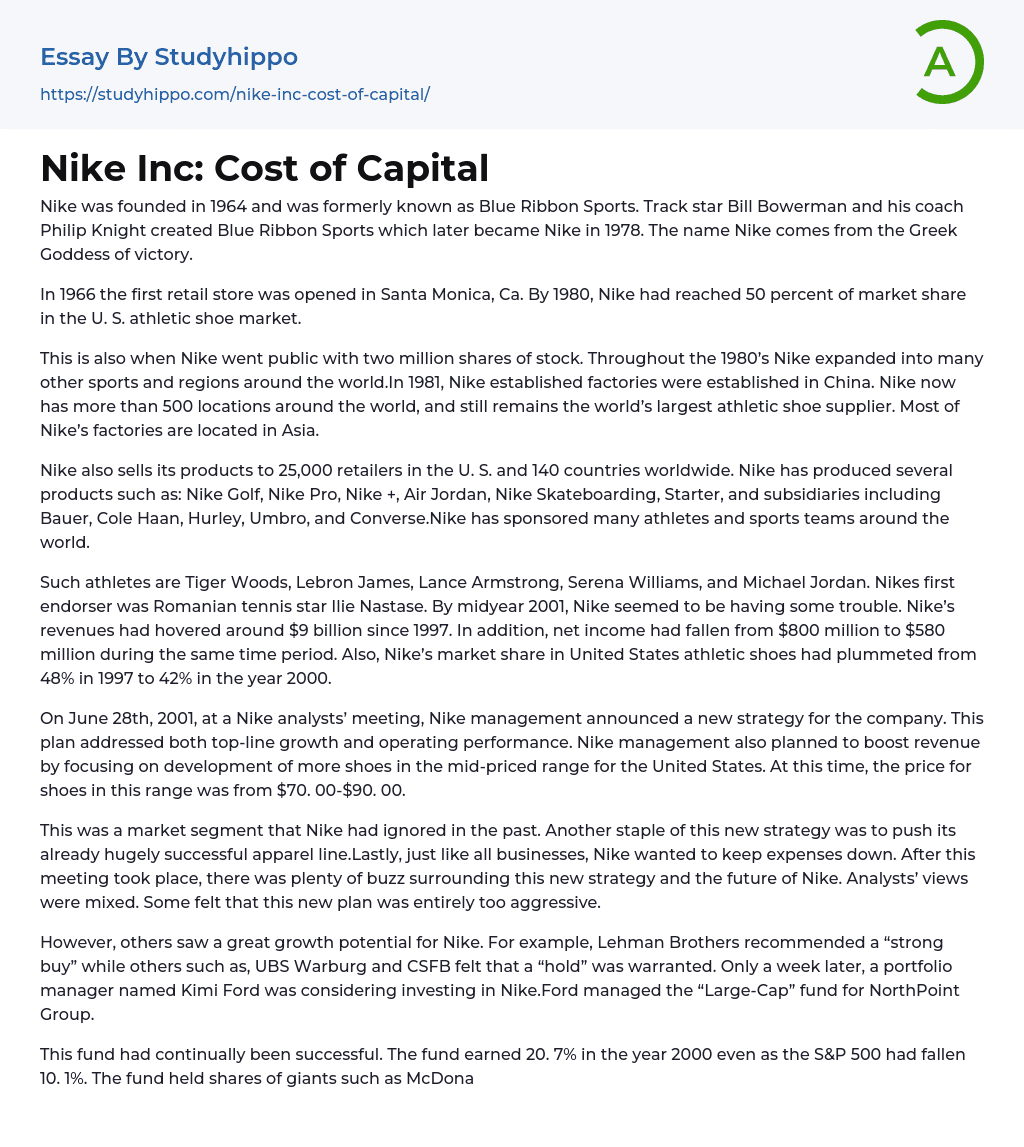Nike was founded in 1964 and was formerly known as Blue Ribbon Sports. Track star Bill Bowerman and his coach Philip Knight created Blue Ribbon Sports which later became Nike in 1978. The name Nike comes from the Greek Goddess of victory.
In 1966 the first retail store was opened in Santa Monica, Ca. By 1980, Nike had reached 50 percent of market share in the U. S. athletic shoe market.
This is also when Nike went public with two million shares of stock. Throughout the 1980’s Nike expanded into many other sports and regions around the world.In 1981, Nike established factories were established in China. Nike now has more than 500 locations around the world, and still remains the world’s largest athletic shoe supplier. Most of Nike’s factories are located in Asia.
Nike also sells its products to 25,000 retailer
...s in the U. S. and 140 countries worldwide. Nike has produced several products such as: Nike Golf, Nike Pro, Nike +, Air Jordan, Nike Skateboarding, Starter, and subsidiaries including Bauer, Cole Haan, Hurley, Umbro, and Converse.Nike has sponsored many athletes and sports teams around the world.
Such athletes are Tiger Woods, Lebron James, Lance Armstrong, Serena Williams, and Michael Jordan. Nikes first endorser was Romanian tennis star Ilie Nastase. By midyear 2001, Nike seemed to be having some trouble. Nike’s revenues had hovered around $9 billion since 1997. In addition, net income had fallen from $800 million to $580 million during the same time period. Also, Nike’s market share in United States athletic shoes had plummeted from 48% in 1997 to 42% in the year 2000.
On June 28th, 2001, at a Nike analysts’ meeting
Nike management announced a new strategy for the company. This plan addressed both top-line growth and operating performance. Nike management also planned to boost revenue by focusing on development of more shoes in the mid-priced range for the United States. At this time, the price for shoes in this range was from $70. 00-$90. 00.
This was a market segment that Nike had ignored in the past. Another staple of this new strategy was to push its already hugely successful apparel line.Lastly, just like all businesses, Nike wanted to keep expenses down. After this meeting took place, there was plenty of buzz surrounding this new strategy and the future of Nike. Analysts’ views were mixed. Some felt that this new plan was entirely too aggressive.
However, others saw a great growth potential for Nike. For example, Lehman Brothers recommended a “strong buy” while others such as, UBS Warburg and CSFB felt that a “hold” was warranted. Only a week later, a portfolio manager named Kimi Ford was considering investing in Nike.Ford managed the “Large-Cap” fund for NorthPoint Group.
This fund had continually been successful. The fund earned 20. 7% in the year 2000 even as the S&P 500 had fallen 10. 1%. The fund held shares of giants such as McDonald’s, 3M, General Motors, and Exxon-Mobil.
Ford read all the analysts’ predictions about Nike that she could find, but they left her with no clear direction. She completed her own discounted-cash-flow model. This forecast gave Ford a discount rate of 12%. Thus, Nike was overvalued at its current price of $42. 09.
However, a quick sensitivity analysis revealed that Nike was undervalued at a discount rate
below 11. 2%. Once again, Ford was left with no clear direction as to what she should do. Unfortunately, Kimi Ford was on her way to an important meeting and running short on time, so she asked her newly hired assistant, Joanna Cohen, to calculate Nike’s cost of capital for her. Cohen gathered the information she needed and completed the task she was given. She then submitted a memorandum to her boss, Kimi Ford, estimating Nike’s cost of capital at 8.
4%.
- Money essays
- Financial Accounting essays
- Market Segmentation essays
- Supply And Demand essays
- Purchasing essays
- Forecasting essays
- Legacy essays
- Bank essays
- Corporate Finance essays
- Financial News essays
- Financial Ratios essays
- Financial Services essays
- Free Market essays
- Shareholder essays
- Personal finance essays
- Equity essays
- Financial Crisis essays
- Banking essays
- Credit Card essays
- Currency essays
- Debt essays
- Gold essays
- Loan essays
- Enron Scandal essays
- Foreign Exchange Market essays
- Investment essays
- Venture Capital essays
- Stock Market essays
- Retirement essays
- Donation essays
- Net Present Value essays
- Income Statement essays
- Commercial Bank essays
- Debit Card essays
- Deposit Account essays
- Subprime Lending essays
- Perfect Competition essays
- Underwriting essays
- Synergy essays
- Valuation essays
- Investing essays
- Asset essays
- Depreciation essays
- Discounted Cash Flow essays
- Foreign Direct Investment essays
- Funds essays
- Internal Rate Of Return essays
- Revenue essays
- Day Trading essays
- Futures Trading essays




